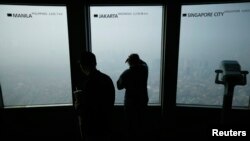SEOUL —
Seoul residents expressed concern about smog blowing from central China on Thursday, with many people seen heading out wearing face masks.
The National Institute of Environmental Research said Seoul's daily average of the density of airborne particles less than 10 micrometers, also called PM10 concentrations, reached 81-124 micrograms on Thursday.
South Korea's Air Quality Information department classified the concentration of PM10 at a level of three out of six, six being the most hazardous.
The smog contains toxic heavy metals such as lead, cadmium and arsenic.
Residents said they were worried about the pollution.
“My bronchial tubes are in a weak condition, and my throat feels very bad when I am outside. Today I watching the news reporting that the density of the fine dust is two or three times higher than usual. I'm worried about my health so I bought masks and came out,” said 27-year-old Kim Bo-yeon.
The polluted air also forced residents to reduce outdoor activities.
“The air is polluted badly due to the fine dust for about a week. I heard that it's coming from China, so I'm worried because it's bad environmentally. I came here by taxi, and the driver is also concerned a lot. I came out with my children together today for an appointment, but I'm bit worried. So we headed out wearing masks,” said 45-year-old Lee Yoon-kyung.
Local media said winds are expected to bring elevated levels of particulate matter and pollution to South Korean cities, which might get worse when Chinese power plants start burning massive amounts of coal for heating during the winter period.
“The recent fine dust is featured by the combination between the sulfide compounds of China's coal heating and industrial area and nitrogen compounds from South Korea's car exhaust fumes. These sulfate and nitrates have a bad influence on bronchial tubes and lungs. Meanwhile, the four-day-long accumulated fine dust is now gradually disappearing, but it's still in the status of ‘Quite Bad.’ So, children, the old and infants, as well as people who suffer from respiratory diseases must be careful,” said South Korea senior researcher Chang Lim-seok, from the air quality team of the Korea Meteorological Administration.
Severe pollution in Beijing has made it “barely suitable” for living, according to an official report published earlier this month, and despite numerous measures aimed at improving air quality in recent years, Beijing still regularly suffers from choking smog.
Chinese authorities have ordered factories to shut and construction sites to stop work to reduce pollution levels.
The National Institute of Environmental Research said Seoul's daily average of the density of airborne particles less than 10 micrometers, also called PM10 concentrations, reached 81-124 micrograms on Thursday.
South Korea's Air Quality Information department classified the concentration of PM10 at a level of three out of six, six being the most hazardous.
The smog contains toxic heavy metals such as lead, cadmium and arsenic.
Residents said they were worried about the pollution.
“My bronchial tubes are in a weak condition, and my throat feels very bad when I am outside. Today I watching the news reporting that the density of the fine dust is two or three times higher than usual. I'm worried about my health so I bought masks and came out,” said 27-year-old Kim Bo-yeon.
The polluted air also forced residents to reduce outdoor activities.
“The air is polluted badly due to the fine dust for about a week. I heard that it's coming from China, so I'm worried because it's bad environmentally. I came here by taxi, and the driver is also concerned a lot. I came out with my children together today for an appointment, but I'm bit worried. So we headed out wearing masks,” said 45-year-old Lee Yoon-kyung.
Local media said winds are expected to bring elevated levels of particulate matter and pollution to South Korean cities, which might get worse when Chinese power plants start burning massive amounts of coal for heating during the winter period.
“The recent fine dust is featured by the combination between the sulfide compounds of China's coal heating and industrial area and nitrogen compounds from South Korea's car exhaust fumes. These sulfate and nitrates have a bad influence on bronchial tubes and lungs. Meanwhile, the four-day-long accumulated fine dust is now gradually disappearing, but it's still in the status of ‘Quite Bad.’ So, children, the old and infants, as well as people who suffer from respiratory diseases must be careful,” said South Korea senior researcher Chang Lim-seok, from the air quality team of the Korea Meteorological Administration.
Severe pollution in Beijing has made it “barely suitable” for living, according to an official report published earlier this month, and despite numerous measures aimed at improving air quality in recent years, Beijing still regularly suffers from choking smog.
Chinese authorities have ordered factories to shut and construction sites to stop work to reduce pollution levels.










